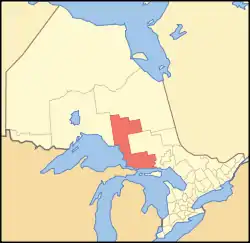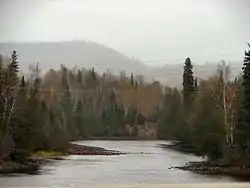Algoma District
Algoma District is a district and census division in Northeastern Ontario in the Canadian province of Ontario.
Algoma District
District d'Algoma | |
|---|---|
 Location of Algoma District in Ontario | |
| Coordinates: 48°00′N 84°30′W | |
| Country | |
| Province | |
| Region | Northeastern Ontario |
| Created | 1858 |
| Area | |
| • Land | 48,814.88 km2 (18,847.53 sq mi) |
| Population (2016)[1] | |
| • Total | 114,094 |
| • Density | 2.3/km2 (6/sq mi) |
| Time zone | UTC-5 (EST) |
| • Summer (DST) | UTC-4 (EDT) |
| Area code | 705 |
| Seat | Sault Ste. Marie |
The name was created by an American ethnologist, Henry Rowe Schoolcraft (1793-1864), who was appointed Indian agent to the Ojibwe in Sault Ste. Marie region in 1822. "Al" is derived from Algonquin, while "goma" is a variant of gomee, meaning lake or water.[2]
Algoma District has shoreline along Lake Superior and Lake Huron. It has an international border crossing to the American state of Michigan, at Sault Ste. Marie. Historically, it was known for its lumber and mining industries.
The rugged scenery of the region has inspired works by Canadian artists, particularly the Group of Seven. They rented a boxcar from the Algoma Central Railway to travel on excursions through this region.
History
Surviving prehistoric remains in Algoma District are concentrated around waterways. These remains date as far back as the Archaic period. There are also sites from the later Woodland period, with evidence of extensive Late Woodland habitation. Ceramics at Late Woodland sites show predominantly southeastern links, having originated from the Huron–Petun complex (broadly Ontario Iroquoian) as well as from modern-day Michigan.[3]: 28
French explorers arrived in the area by the mid-17th century. As the French penetrated into North America, they established lines of forts and trading posts, often at river mouths to control trade, especially the lucrative fur trade. In Algoma, they established Fort Michipicoten, located at the mouth of the Michipicoten River where it empties into Lake Superior. The Michipicoten was one of the geographic features depicted by Samuel de Champlain on a 1632 map.[4]: 17 This helped the French bridge the distance to Fort Kaministiquia at the head of Lake Superior, and protected the route up the Michipicoten to James Bay, providing a significant crossroads of water routes.
Administrative history
Algoma was created by proclamation in 1858[5] as a provisional judicial district of the Province of Canada comprising territory north of the French River as far west as Pigeon River, including all Canadian islands in Lakes Huron and Superior. The authorizing act of the Legislative Assembly of the Province of Canada was An Act to provide for the Administration of Justice in the unorganized Tracts of Country within the limits of this Province (known by its short title as The Temporary Judicial Districts Act, 1857).
The district seat has been Sault Ste. Marie since 1858.
As the population grew and the northern and northwestern boundaries of Ontario were determined by the Judicial Committee of the Privy Council, Algoma shrank. Other districts were created from it by the provincial government of Ontario:
- Thunder Bay District in 1871
- Manitoulin District in 1888
- Sudbury District in 1894
- Timiskaming District in 1912
Geography
Rivers

Algoma District is crossed by a number of rivers, which historically were used as transportation and trade corridors. The Hudson's Bay Company chose key riverside or river mouth locations for a number of its trading posts in the district. One example was Fort Michipicoten, located at the Michipicoten River's mouth. The rivers flow in a number of directions, some crossing through other districts to ultimately empty into faraway water bodies such as James Bay. Others drain into the Great Lakes Basin via Lake Huron or Lake Superior.
Major rivers in Algoma District include:
- Batchawana River (empties into Batchawana Bay on Lake Superior)
- Michipicoten River (empties into Michipicoten Bay on Lake Superior)
- Missinaibi River (originates at Missinaibi Lake and empties into the Moose River, then ultimately into James Bay)
- Mississagi River (originates in Sudbury District and flows into Lake Huron)
- Kapuskasing River (begins at Kapuskasing Lake and flows northward to James Bay)
Forests
In the Algoma section, the characteristic forest mixture consists of yellow birch, white spruce, balsam fir, sugar maple, hop-hornbeam, and eastern white cedar. Eastern white pine and occasional red pine (Pinus resinosa) dominate on the upper, steep south-facing slopes; white spruce, eastern white cedar, and balsam fir occupy the middle and lower slopes. A white spruce–balsam fir association, which usually includes white birch and black spruce, is prominent on the river terraces and adjoining flats in the northern part of the Section (Rowe 1972).[6]
Subdivisions
Communities within these subdivisions are added in parentheses.
Cities
| Name of City | Population | Ref. |
|---|---|---|
| Elliot Lake | 10,743 | |
| Sault Ste. Marie | 73,368 |
Towns
| Name of Town | Population | Ref. |
|---|---|---|
| Blind River | 3,472 | |
| Bruce Mines | 566 | |
| Spanish | 696 | |
| Thessalon | 1,279 |
Townships
| Name of Township | Population | Ref. |
|---|---|---|
| Dubreuilville | 635 | |
| Hilton | 261 | |
| Hornepayne | 1,050 | |
| Huron Shores (Iron Bridge, Sowerby, Little Rapids, Dean Lake) | 1,723 | |
| Jocelyn (Kentvale) | 237 | |
| Johnson (Desbarats) | 750 | |
| Laird | 1,057 | |
| Macdonald, Meredith and Aberdeen Additional (Echo Bay, Bar River, Sylvan Valley) | 1,609 | |
| The North Shore (Spragge, Serpent River, Algoma Mills) | 509 | |
| Plummer Additional | 650 | |
| Prince | 1,031 | |
| St. Joseph (Richard's Landing) | 1,240 | |
| Tarbutt | 396 | |
| Wawa (Michipicoten, Michipicoten River) | 2,975 | |
| White River | 607 |
Villages
| Name of Village | Population | Ref. |
|---|---|---|
| Hilton Beach | 145 |
Reserves
| Name of Reserve | Population | Ref. |
|---|---|---|
| Garden River 14 | 1,170 | |
| Goulais Bay 15A | 82 | |
| Gros Cap 49 | 68 | |
| Gros Cap Indian Village 49A | N/A | |
| Missanabie 62 | N/A | |
| Mississauga First Nation#8 | 390 | |
| Obadjiwan 15E | N/A | |
| Rankin Location 15D | 566 | |
| Sagamok | 1,036 | |
| Serpent River 7 | 373 | |
| Thessalon 12 | 108 | |
| Whitefish Island | N/A |
Unorganized areas
Demographics
As a census division in the 2021 Census of Population conducted by Statistics Canada, the Algoma District had a population of 113,777 living in 51,709 of its 59,854 total private dwellings, a change of −0.3% from its 2016 population of 114,094. With a land area of 48,281.36 km2 (18,641.54 sq mi), it had a population density of 2.4/km2 (6.1/sq mi) in 2021.[7]
| 2021 | 2016 | 2011 | |
|---|---|---|---|
| Population | 113,777 (-0.3% from 2016) | 114094 (−1.5% from 2011) | 115870 (−1.4% from 2006) |
| Land area | 48,281.36 km2 (18,641.54 sq mi) | 48,814.88 km2 (18,847.53 sq mi) | 48,810.68 km2 (18,845.91 sq mi) |
| Population density | 2.4/km2 (6.2/sq mi) | 2.3/km2 (6.0/sq mi) | 2.4/km2 (6.2/sq mi) |
| Median age | 50.0 (M: 48.4, F: 51.2) | ||
| Private dwellings | 59,854 (total) 51,709 (occupied) | 60,324 (total) | 59,149 (total) |
| Median household income | $70,000 |
Highways
Secondary highways
Tertiary highways
- #821
Protected areas
|
|
Attractions
- Algoma Central Railway - Agawa Canyon (Algoma, Unorganized, North Part)
- Algoma University (Sault Ste. Marie)
- Fire Tower Lookout (Elliot Lake)
- Fort St. Joseph National Historic Site (St. Joseph)
- High Falls of the Michipicoten River (Wawa)
- Mount Dufour Ski Resort (Elliot Lake)
- Sault Ste. Marie Airport (Sault Ste. Marie)
- Sault Ste. Marie Canal (Sault Ste. Marie)
- Sault College (Sault Ste. Marie)
- Searchmont Ski Area
- Stone Ridge Golf Resort (Elliot Lake)
- Crimson Ridge Golf Course
- Batchawana Bay Provincial Park
- Hub Trail (hiking, bicycling, and cross-country ski trail through Sault Ste. Marie)
- Rocking On The River (Wandering-Elk Promotion & Productions), Concert Venue @ 135 Royer Rd., Blind River.
References
- "Algoma District census profile". 2016 Census of Population. Statistics Canada. 8 February 2017. Retrieved 2017-02-08.
- Hamilton, William (1978). Canadian Place Names. Macmillan. p. 132. ISBN 0-7715-9754-1.
- Dawson, K. C. A. (1971). "Michipicoten Survey 1971, Algoma District, Ontario". Bulletin (Canadian Archaeological Association). Canadian Archaeological Association (3): 27–38. JSTOR 41242334.
- Douglas, Dan (1995). Northern Algoma: A People's History. Toronto: Dundurn Press. ISBN 1-55002-235-0.
- Proclamation to take effect 1 May 1858, Canada Gazette (April 17, 1858), p. 676-677. New Proclamation to take effect 1 Oct 1859, Canada Gazette (Sept 10, 1859), p. 2226.
- Rowe, J.S 1972. Forest regions of Canada. Can. Dep. Environ., Can. For. Serv., Ottawa ON, Publ. 1300. 172 p.
- "Population and dwelling counts: Canada and census divisions". Statistics Canada. February 9, 2022. Retrieved April 2, 2022.
- "2021 Community Profiles". 2021 Canadian Census. Statistics Canada. February 4, 2022. Retrieved 2023-10-19.
- "2016 Community Profiles". 2016 Canadian Census. Statistics Canada. August 12, 2021. Retrieved 2017-04-17.
- "2011 Community Profiles". 2011 Canadian Census. Statistics Canada. March 21, 2019. Retrieved 2012-03-19.
- "2006 Community Profiles". 2006 Canadian Census. Statistics Canada. August 20, 2019.
- "2001 Community Profiles". 2001 Canadian Census. Statistics Canada. July 18, 2021.
Further reading
- Douglas, Daniel G. V. (July 1996). Northern Algoma: A People's History. Dundurn Press. ISBN 978-1-55002-235-3.
